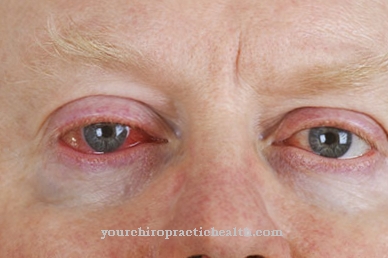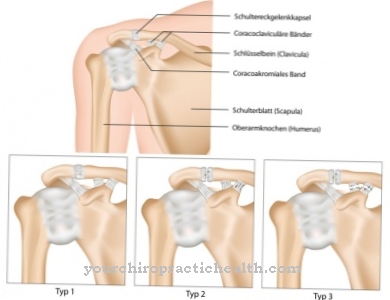The Bloom Syndrome is a very rare, genetically inherited disease. It is characterized by increased genetic instability. The patients are short and more likely to develop cancer. Because of the increased vascular markings in the tumors, Bloom's syndrome becomes too Telangiectatic Syndrome called.
What is Bloom Syndrome?

© booka - stock.adobe.com
Bloom syndrome belongs to the group of chromosome break syndromes. Many different clinical symptoms result from the dysregulation of enzymes that replicate and repair DNA. Defective repair mechanisms cause (spontaneous) mutations to accumulate in the genes.
The increased mutation rate represents an increased susceptibility to cancer. Pre- and postnatal growth disorders, reduced subcutaneous fatty tissue, and light-sensitive skin that tends to redden and inflammation are also characteristic.
Bloom syndrome is inherited as an autosomal recessive trait. This means that both parents must be carriers of the diseased gene for your child to become clinically abnormal. The probability that the child will fall ill is thus statistically 25 percent. A total of 300 cases are currently described. Ashkenazi Jews, however, are at an increased risk of Bloom syndrome.
causes
Bloom syndrome is caused by a mutation in the BLM gene. This gene is responsible for the production of proteins such as the RecQ helicases. Helicases are enzymes that split the DNA double strands into two single strands. This process is necessary to allow replication (duplication of DNA).
This creates a second so-called sister chromosome from one chromosome. While the DNA is multiplying, the BLM protein checks the sister chromosome for errors and initiates corrections. If the gene or protein is defective, mutations often go undetected and can cause great damage in the organism. Common changes in the genome are nucleotide insertion / deletion and nonsense mutations.
Symptoms, ailments & signs
Patients are often proportionally short and have a different shape of the skull bones. This is already evident during pregnancy. Newborns, infants, and young children have decreased appetites. A possible cause for this could be the frequent gastroesophageal reflux, also called heartburn. In addition, Bloom syndrome patients are prone to otitis media, pneumonia and aspiration of stomach contents.
The skin of infants is often normal at birth. With increasing exposure to the sun in the first year of life, the tendency to form red, inflammatory skin lesions increases. The nose, cheeks, back of the hand and forearm are particularly affected. In addition, there are frequent café-au-lait spots, benign light brown skin spots.
In contrast to women, men are often infertile (incapable of childbearing). So far, eleven women have become pregnant despite the disease and have given birth to at least one healthy child. The intelligence of patients with Bloom syndrome is usually not reduced.
Diagnosis & course
A diagnosis of Bloom syndrome is considered when the following findings are present:
- an inexplicable short stature during pregnancy that lasts until adulthood or
- a significant short stature and reddish skin lesions on the face after exposure to the sun or
- a significant short stature associated with early childhood cancer.
A genetic test is always used to confirm the diagnosis. A single gene or several genes can be examined here. The diagnosis is confirmed when a patient has two pathological changes in the region of the BLM gene. This test can be carried out before birth as part of the prenatal diagnosis.
As the disease progresses, constrictions in the ureter often occur in men. Chronic obstructive pulmonary disease (COPD) resulted in death in some patients. Diabetes mellitus was diagnosed in about 50 patients, but mostly without complications.
Some patients developed leukemia, which could be controlled by chemotherapy and radiation therapy. Cancer is the most common clinical complication. It is the leading cause of death in Bloom syndrome. Most of the patients developed lymphoma, a cancer of the lymphatic system. Different types of skin cancers are also common. A total of 207 out of 300 patients developed cancer.
Complications
Unfortunately, there is no therapy for Bloom syndrome, which is why some symptoms and complications can arise in the course of the disease. In most cases, Bloom syndrome leads to short stature. This has a negative effect on the quality of life and can lead to psychological problems and depression. Short stature can also lead to teasing in children.
There are also malformations and deformations of the skull, but these do not have a negative effect on life. The disease also has a greatly increased sensitivity to the sun, which can lead to hypopigementation. The person concerned has to apply more sunscreen lotion to prevent tumor diseases on the skin.
However, the hypopigmentation does not lead to any further complications. Due to Bloom's syndrome, the patient is more susceptible to infections due to a weakened immune system. Those affected often suffer from inflammation and infections, which would not lead to illness in healthy people. The immune defects lead to a reduced life expectancy. Leukemia can also occur in the course of life, which leads to pain and severe restrictions in everyday life.
When should you go to the doctor?
In most cases, the symptoms of Bloom's syndrome appear relatively early in the person's childhood. A doctor should be seen immediately as patients with this syndrome are more likely to develop cancer. Regular examinations are also necessary.
A doctor should be consulted if the patient has short stature. Altered bones in the skull or reflux disease can also indicate Bloom's syndrome and should be investigated. Furthermore, constant inflammation of the ears or pneumonia can indicate this syndrome and must also be examined. Patients also suffer from skin lesions from exposure to the sun, which must also be treated to prevent skin cancer. The infertility of patients with Bloom syndrome cannot usually be treated.
The diagnosis of the syndrome is made by a pediatrician or general practitioner. However, further treatment is carried out by the respective specialist. The earlier treatment for the syndrome begins, the longer the patient's life expectancy.
Doctors & therapists in your area
Treatment & Therapy
There is currently no curative, i.e. healing, therapy. Approaches for this would be gene therapies. Rather, the therapy lies in the prevention of complications. A thorough physical examination is necessary and complications can be identified and treated early on. Gastroesophageal reflux can be treated with a proton pump inhibitor, such as pantoprazole.
Regular checks of the blood sugar level could prevent diabetes mellitus or reduce the secondary diseases of diabetes mellitus. To check the immune system, immunoglobulin concentrations are measured in the blood plasma. Men should have a regular urological examination.
Patients under 20 should be checked regularly for leukemia. Colon cancer should also be searched for, as this is the most common solid tumor in humans. At least one colonoscopy should be done every year. The stool should be tested for blood two to four times a year.
Psychosocial care for the patient and the family is also important. A serious, chronic illness not only affects the patient, but also always his relatives. Joint discussions promote the relationship and increase the therapeutic success.
Outlook & forecast
With the current medical and scientific possibilities there is no cure for Bloom syndrome. Therefore, the prognosis for this disease is to be classified as unfavorable. The gene mutation cannot yet be cured with the available therapy options. For legal reasons, interference with human genetics is not permitted. This diminishes the prospect of a permanent cure.
In the case of Bloom syndrome, treatment is particularly aimed at reducing the accompanying symptoms. In addition, various preventive examinations are offered, which are used to diagnose possible tissue changes in good time. Due to Bloom's syndrome, patients are more likely to suffer from tumor diseases with a malignant course. Young people in particular are affected and should have appropriate tests carried out at regular intervals.
Even if the condition cannot be cured, there are ways that the patient's general well-being can be improved. Relaxation techniques, psychotherapeutic support and a healthy lifestyle help to strengthen the organism and build courage.
This is helpful in order to be able to deal with the disease better in everyday life and to have sufficient resources if the sequelae of Bloom syndrome arise. With a strengthened and stable immune system, the patient is better able to mobilize the necessary defenses and to reduce the healing process for other diseases.
prevention
Genetic counseling and examinations can help families find out whether there is a relevant risk of a genetic, inheritable disease. In addition to an educational talk, genome examinations take place. The results can help families better plan their family.
In order to reduce the risk of spontaneous mutations, a healthy, active lifestyle is recommended. Smoking and an unhealthy diet should be avoided as these increase the likelihood of a mutation. Late pregnancies always have an increased risk of a genetic disease in the child.
Aftercare
The rarely occurring congenital telangiectatic syndrome is one of the chromosome break syndromes. Because of this and because of the serious damage, treatment and aftercare are difficult. It remains to be hoped that gene therapy can anticipate such damage prenatally in the future.
The options for follow-up care mostly relate to individual symptoms or consequential damage from Bloom syndrome. Rather, it is important to take preventive measures, as patients with Bloom syndrome often develop cancer because of the associated gene mutations. In addition, thanks to the high susceptibility to infection, preventive measures in the form of antibiotic prophylaxis as well as a subsequent build-up of the intestinal flora for the purpose of better immune activity may be necessary.
For common problems such as reflux syndrome, acute middle ear infections or pneumonia, something can be done with aftercare. The high sensitivity to light, which leads to various skin damage, can also be treated dermatologically in follow-up care. But prevention is just as necessary as there is an increased tendency to develop skin cancer. If this is operated on, wound care in aftercare is just as important as regular searches for new skin cancer foci.
Compared to live vaccines, Bloom syndrome has limited usability. Therefore, prevention against certain illnesses such as flu is more important than any aftercare. If a preventable disease breaks out due to the problems with live vaccines, follow-up care is inevitable. It depends on the type and severity of the disease.
You can do that yourself
The cause of Bloom syndrome cannot yet be treated. Therapy focuses on relieving symptoms and discomfort. However, patients suffering from the disease can take some measures to support medical treatment and to positively influence the healing process.
First of all, a specialist should be consulted with Bloom syndrome. Since the disease can express itself in different ways and often also develop very differently, professional advice is required. Usually several examinations are required, which is why the patient should take appropriate precautions for a longer stay in the clinic.
After the therapy has been determined, the patient should take it easy. To strengthen the immune system, moderate physical exercise is useful. A healthy diet reduces the risk of secondary diseases and improves well-being.
Patients under 20 should get regular checkups. As there is an increased risk of leukemia or colon cancer, attention should be paid to any noticeable symptoms in these areas. For example, if there is unspecific tenderness on pressure in the gastrointestinal tract, this must be clarified. Psychological support for the patient and his relatives is also important.
A serious illness is an enormous burden for those affected and has to be dealt with. Joint discussions improve the patient's mental state and often also have a positive effect on the course of the disease.




.jpg)






















